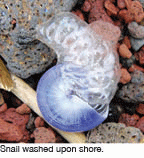

 God has designed life so that it can be found everywhere on our planet. Many times what is useful on land is not useful in the sea and vice-versa, but sometimes it just has to be modified in its design to enable it to function. Most of us are familiar with snails. We have seen land snails in our gardens and know that their scientific name, Gastropoda, pretty well describes how they function. Gastro refers to their digestive system and pod refers to their foot. This snail secrets a slime or mucus which it slides along giving it its slow locomotion on land. This slime also sends out chemical signals to others of its species.
God has designed life so that it can be found everywhere on our planet. Many times what is useful on land is not useful in the sea and vice-versa, but sometimes it just has to be modified in its design to enable it to function. Most of us are familiar with snails. We have seen land snails in our gardens and know that their scientific name, Gastropoda, pretty well describes how they function. Gastro refers to their digestive system and pod refers to their foot. This snail secrets a slime or mucus which it slides along giving it its slow locomotion on land. This slime also sends out chemical signals to others of its species.
In the ocean there is a family of snails called Janthinidae which uses the slime to form rafts. The snail folds its foot around a pocket of air making a bubble. The bubble is then attached to other bubbles making a floating raft which becomes a home to the female snail and eventually to a mate. The snails can produce a bubble a minute.
The design of the snails to allow this unique method of living and reproducing is remarkable. The snails not only have mucus secretions that allow the trapping and attaching of air, but they do not have gravity-sensing organs so they can live anywhere on the raft and not have the limitation of having to respond to gravity to eat or move. The snails are hermaphroditic, meaning that all of this species of snails eventually become females at adulthood. When the babies are produced they are larvae which simply tumble into the ocean. Being less dense than sea water they bob around until they are able to produce their own rafts.
Romans 1:20 tell us that we can know there is a God “through the things that are made.” The design of creatures like the bubble-rafting snails challenge our imagination, not only to conceive of a creature that can live uniquely in a difficult environment, but can be engineered and constructed to have all the tools needed to survive successfully. Source: National Geographic, April 2012, page 23.
Picture credits:
http://commons.wikimedia.org/wiki/File:Janthina.jpg
